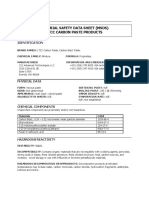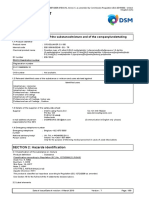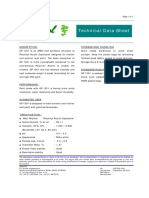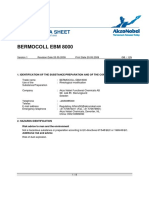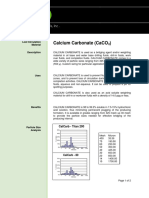Byk 037
Byk 037
Uploaded by
AmiCopyright:
Available Formats
Byk 037
Byk 037
Uploaded by
AmiOriginal Description:
Original Title
Copyright
Available Formats
Share this document
Did you find this document useful?
Is this content inappropriate?
Copyright:
Available Formats
Byk 037
Byk 037
Uploaded by
AmiCopyright:
Available Formats
Material Safety Data Sheet
BYK-037
Version
Revision Date 08/08/2008
Print Date 08/08/2008
SECTION 1. PRODUCT AND COMPANY IDENTIFICATION
Product name
Product Use Description
:
:
BYK-037
Defoamers for Emulsion Paints and Emulsion Plasters
Company
Prepared by
Telephone
Visit our web site
E-mail address
Emergency telephone
:
:
:
:
:
BYK USA Inc.
524 South Cherry Street
Wallingford CT 06492
J.Nole, Safety; M.McCutcheon, Regulatory
(203) 265-2086
www.byk.com
ehs.byk.usa@altana.com
CHEMTREC 800-424-9300
SECTION 2. HAZARDS IDENTIFICATION
Emergency Overview
Form
Colour
Odour
: liquid
: white
: not significant
OSHA Regulatory Status
This material is considered hazardous by the OSHA Hazard Communication Standard (29
CFR1910.1200)
Potential Health Effects
Eyes
: Contact may cause irritation.
Skin
: Contact may cause irritation.
Ingestion
: Ingestion may irritate the digestive tract; high dosages may
cause CNS depression.
Inhalation
: High concentrations of vapors resulting from the product being
heated, misted or sprayed may cause irritation of the
respiratory tract and mucous membranes.
Chronic Exposure
: Chronic skin contact with saturated hydrocarbons has caused
dermatitis.
Aggravated Medical
Condition
: May be aggravating to some
skin conditions
asthma-type conditions
Primary Routes of Entry
: Skin contact
Skin absorption
Inhalation
1/9
Material Safety Data Sheet
BYK-037
Version
Revision Date 08/08/2008
Print Date 08/08/2008
Eyes
Ingestion
Carcinogenicity:
No component of this product present at levels greater than or equal to 0.1% is identified as probable,
possible or confirmed human carcinogen by IARC.
No component of this product present at levels greater than or equal to 0.1% is identified as a
carcinogen or potential carcinogen by OSHA.
No component of this product present at levels greater than or equal to 0.1% is identified as a known
or anticipated carcinogen by NTP.
No component of this product present at levels greater than or equal to 0.1% is identified as a
carcinogen or potential carcinogen by ACGIH.
Environmental Effects
Environmental Effects
: No information available.
SECTION 3. COMPOSITION/INFORMATION ON INGREDIENTS
Chemical nature
Emulsion of paraffin based mineral oils and hydrophobic components, containing silicone
Hazardous components
Component
CAS-No.
Weight %
Distillates (petroleum)
64741-88-4
hydrotreated heavy paraffinic
30.00 - 60.00
SECTION 4. FIRST AID MEASURES
First aid procedures
Inhalation
Remove to fresh air. Administer artificial respiration if
necessary. Get medical aid as soon as possible.
Skin contact
Remove contaminated clothing. Wash thoroughly with soap
and water.
Eye contact
Immediately flush with plenty of water for at least 20 minutes.
Get medical aid.
2/9
Material Safety Data Sheet
BYK-037
Version
Ingestion
Revision Date 08/08/2008
Print Date 08/08/2008
Do not induce vomiting; aspiration hazard. Dilute with 1-2
glasses of water. Get medical aid. If vomiting occurs
spontaneously, keep head below hips to prevent aspiration of
liquid into lungs.
No information available.
Notes to physician
Risks
SECTION 5. FIRE-FIGHTING MEASURES
Flammable properties
Flash point
> 110 C (> 230.00 F)
Method: 49 (Pensky-Martens)
Ignition temperature
> 200 C (> 392.00 F)
Method: calculated
Suitable extinguishing
media
Foam
Carbon dioxide (CO2)
Dry chemical
Unsuitable extinguishing
media
Special protective
equipment for fire-fighters
Specific hazards during fire
fighting
No information available.
In the event of fire, wear self-contained breathing apparatus.
Cool closed containers exposed to fire with water spray.
Will not explode on mechanical impact.
Hazardous decomposition
products due to incomplete
combustion.
Carbon oxides
nitrogen oxides (NOx)
Sulphur oxides
silicone compounds
formaldehyde
Further information
Keep away from heat and sources of ignition.
SECTION 6. ACCIDENTAL RELEASE MEASURES
Personal precautions
Wear protective equipment: goggles, chemically resistant
clothing and gloves, and appropriate respirator if in a confined
area.
Environmental precautions
Prevent spilled material from entering the ground, water and/or
3/9
Material Safety Data Sheet
BYK-037
Version
Revision Date 08/08/2008
Print Date 08/08/2008
air by using appropriate containment methods.
Methods for containment
Stop leak. Dike and contain spill.
Methods for cleaning up
Pump into salvage tanks and/or absorb with suitable material.
Use sparkless shovels to remove material.
Additional advice
No further information is available.
SECTION 7. HANDLING AND STORAGE
Handling
Handling
Avoid contact with skin and eyes.
Avoid breathing dust/fume/gas/mist/vapours/spray.
Handle as an industrial chemical.
Keep container tightly closed.
Keep away from oxidizing agents.
Keep in a dry, cool and well-ventilated place.
Storage
Advice on common storage
SECTION 8. EXPOSURE CONTROLS / PERSONAL PROTECTION
Exposure Guidelines
Components with workplace control parameters
Components
CAS-No.
Value
Distillates
(petroleum)
hydrotreated
heavy paraffinic
64741-88-4
TWA
Control
parameters
5 mg/m3
Update
Basis
2005-1-1
ACGIH
Engineering measures
Engineering measures
: Use with local exhaust ventilation.
Personal protective equipment
Eye protection
: Safety Glasses
Goggles
Hand protection
: Neoprene gloves
Skin and body protection
: Choose body protection according to the amount and
4/9
Material Safety Data Sheet
BYK-037
Version
Revision Date 08/08/2008
Print Date 08/08/2008
concentration of the dangerous substance at the work place.
Respiratory protection
: Unless air monitoring demonstrates vapor/mist/dust levels are
below the PEL/TLV wear a properly fitted respirator (NIOSH
approved) or dust mask during exposure.
Hygiene measures
: Clean long legged, long sleeved work clothes.
Handle in accordance with good industrial hygiene and safety
practice.
SECTION 9. PHYSICAL AND CHEMICAL PROPERTIES
Form
Colour
Odour
Odor Threshold
Flash point
:
:
:
:
:
liquid
white
not significant
no data available
> 110 C (> 230.00 F)
Method: 49 (Pensky-Martens)
Ignition temperature
: > 200 C (> 392.00 F)
Method: calculated
Lower explosion limit
Upper explosion limit
pH
Freezing Point
Initial boiling point
:
:
:
:
:
Vapour pressure
: 24.0000000 hPa
at 20 C (68.00 F)
Method: calculated
Evaporation rate
Density
: no data available
: 0.9350 g/cm3
at 20 C (68.00 F)Method: DIN EN ISO 2811-3
Bulk density
: not applicable
Water solubility
: immiscible
Partition coefficient: noctanol/water
Viscosity, kinematic
: no data available
no data available
no data available
no data available
no data available
100 C (212.00 F)
: at 20 C (68.00 F)
no data available
> 7.000 mm2/s
at 40 C (104.00 F)
Relative vapour density
: no data available
5/9
Material Safety Data Sheet
BYK-037
Version
Revision Date 08/08/2008
Print Date 08/08/2008
SECTION 10. STABILITY AND REACTIVITY
Conditions to avoid
: None known.
Materials to avoid
: Strong oxidizing agents
Hazardous decomposition
products
Chemical stability
: None expected
: Stable; polymerization will not occur
SECTION 11. TOXICOLOGICAL INFORMATION
Acute oral toxicity (Product)
no data available
Acute oral toxicity
(Component)
Component: 64741-88-4 Distillates (petroleum) hydrotreated
heavy paraffinic
LD50 rat
Dose: > 15,000 mg/kg
Acute dermal toxicity
(Component)
Component: 64741-88-4 Distillates (petroleum) hydrotreated
heavy paraffinic
LD50 rabbit
Dose: > 5,000 mg/kg
Acute inhalation toxicity
(Component)
Component: 64741-88-4 Distillates (petroleum) hydrotreated
heavy paraffinic
LC50
no data available
Skin irritation (Product)
no data available
Skin irritation (Component)
Component: 64741-88-4 Distillates (petroleum) hydrotreated
heavy paraffinic
rabbit
Result: slight irritation
Eye irritation (Product)
no data available
Eye irritation(Component)
Component: 64741-88-4 Distillates (petroleum) hydrotreated
heavy paraffinic
rabbit
Result: Mild eye irritation
Sensitisation (Product)
no data available
6/9
Material Safety Data Sheet
BYK-037
Version
Revision Date 08/08/2008
Print Date 08/08/2008
SECTION 12. ECOLOGICAL INFORMATION
Additional ecological
information (Product)
no data available
SECTION 13. DISPOSAL CONSIDERATIONS
Further information
Dispose of in accordance with applicable local/municipal,
state/provincial and federal regulations.
SECTION 14. TRANSPORT INFORMATION
Container sizes: 55 gallon drums, 5 or 6-gallon pails, 2oz/16oz samples)
DOT
Not dangerous goods
IATA
Not dangerous goods
IMDG_US Not dangerous goods
SECTION 15. REGULATORY INFORMATION
HMIS Classification
: Health Hazard: 1
Chronic Health Hazard: *
Flammability: 1
Reactivity: 0
PPI:B
National Fire Protection
Association (NFPA) Class
: IIIB
Emergency Planning Community Right-To-Know (EPCRA)
SARA 302 Components
: SARA 302: No chemicals in this material are subject to the
reporting requirements of SARA Title III, Section 302.
If listed below, this product contains toxic chemical(s) subject to the reporting requirements of Section
313 of Title III of the Superfund Amendments and Reauthorization Act of 1986 and 40 CFR part 372.
SARA 311/312 Hazards
: Chronic Health Hazard
Toxic Substances Control Act (TSCA)
TSCA Status
: We certify that all of the components of this product are either
7/9
Material Safety Data Sheet
BYK-037
Version
Revision Date 08/08/2008
Print Date 08/08/2008
listed on the TSCA Inventory or are not subject to the
notification requirements (exempt)
Section 4 / 12(b)
: Not applicable
Clean Air Act & Related Information
Non-volatile (Wt)
: 51.5 - 55.5 %
Method: 22 (10min/150C)
DIN EN ISO 3251
Ozone Depleting
Substances
: Not applicable.
Non-volatile information is not a specification.
Hazardous Air Pollutants
If not listed above, this product does not contain HAPs at 1% or 0.1% or greater. Refer to Section 3
for HAP weight percentage.
Resource Conservation and Recovery Act
EPA Hazardous Waste
Code(s)
: D018
Benzene
State Laws
Massachusetts Right To
Know Components
: No components are subject to the Massachusetts Right to Know
Act.
Pennsylvania Right To
Know Components
: Distillates (petroleum) hydrotreated 64741-88-4
heavy paraffinic
Water
7732-18-5
New Jersey Right To
Know Components
: Distillates (petroleum) hydrotreated 64741-88-4
heavy paraffinic
Water
7732-18-5
-
New Jersey Trade Secret
Registry Number for the
product (NJ TSRN)
: 800963-5150
8/9
Material Safety Data Sheet
BYK-037
Version
California Prop. 65
Components
Revision Date 08/08/2008
Print Date 08/08/2008
: WARNING: This product contains a chemical(s) known to the
State of California to cause cancer and birth defects or other
reproductive harm.
Benzene, 1,4-Dioxane, Acetaldehyde, Ethylene oxide, Toluene
CONEG Heavy Metal: We certify that this product does not contain Lead, Mercury, Cadmium or
hexavalent chromium in the sum concentration of 100 ppm by weight or greater.
Canadian Environmental Protection Act
Domestic Substances List
DSL Status
WHMIS Classification
: We certify that all of the components of this product are listed
on the DSL.
: Not controlled
SECTION 16. OTHER INFORMATION
Further information
The information provided in this Safety Data Sheet is correct to the best of our knowledge,
information and belief at the date of its publication. The information given is designed only as a
guidance for safe handling, use, processing, storage, transportation, disposal and release and is
not to be considered a warranty or quality specification. The information relates only to the
specific material designated and may not be valid for such material used in combination with any
other materials or in any process, unless specified in the text.
9/9
You might also like
- Safety Data Sheet: 1 IdentificationDocument10 pagesSafety Data Sheet: 1 IdentificationGautamNo ratings yet
- Msds BMW Colorsystem Touchup Paint MATERIAL SAFETY DATA SHEETDocument6 pagesMsds BMW Colorsystem Touchup Paint MATERIAL SAFETY DATA SHEETAnonymous PJKeek8cld100% (1)
- Evonik Ancamine 1856 - SDSDocument13 pagesEvonik Ancamine 1856 - SDStrường phạmNo ratings yet
- Lutensol TO 12 SdsDocument13 pagesLutensol TO 12 SdsGülşah Özkula DemirakNo ratings yet
- Clariant TLP Brosch 2Document22 pagesClariant TLP Brosch 2mutazsalihNo ratings yet
- Material Safety Data Sheet (MSDS) LTCC Carbon Paste ProductsDocument4 pagesMaterial Safety Data Sheet (MSDS) LTCC Carbon Paste ProductsUfuk AkkasogluNo ratings yet
- Arcroma Lutexal Additive HVWDocument13 pagesArcroma Lutexal Additive HVWClub classic 350No ratings yet
- Selective Serotonin Reuptake Inhibitors - Past, Present and Future - S. Stanford (Landes, 1999) WWDocument237 pagesSelective Serotonin Reuptake Inhibitors - Past, Present and Future - S. Stanford (Landes, 1999) WWKitty CristinaNo ratings yet
- Tarea #3: Difusión en Estado Estacionario y Pseudoestacionario Sin Reacción QuímicaDocument8 pagesTarea #3: Difusión en Estado Estacionario y Pseudoestacionario Sin Reacción QuímicaDiego Fidel Gonzalez ContrerasNo ratings yet
- Byk 9133Document10 pagesByk 9133tpr314No ratings yet
- BLUESIL BP 9710 RepelenteDocument3 pagesBLUESIL BP 9710 Repelentehector mauricio paez cantorNo ratings yet
- Msds Codex 661 - Rev-01MSDS CODEX 661Document6 pagesMsds Codex 661 - Rev-01MSDS CODEX 661manlekNo ratings yet
- Tergitol XD PDFDocument10 pagesTergitol XD PDFIsmael Enrique ArciniegasNo ratings yet
- Shivena-10 - MSDSDocument8 pagesShivena-10 - MSDSMohamed HalemNo ratings yet
- Material Safety Data Sheet PVADocument4 pagesMaterial Safety Data Sheet PVARatna SariNo ratings yet
- Clariant SDS NIPAGIN M Indonesia EnglishDocument16 pagesClariant SDS NIPAGIN M Indonesia EnglishSetia BudiNo ratings yet
- Crosslinker CX100 MsdsDocument59 pagesCrosslinker CX100 MsdsMimi rastamNo ratings yet
- Stoving Paint MsdsDocument9 pagesStoving Paint MsdsrajangangarNo ratings yet
- Primal CM 219Document7 pagesPrimal CM 219Alaa Khaled MeetkeesNo ratings yet
- Bayhydur XP 2655 MSDS PDFDocument10 pagesBayhydur XP 2655 MSDS PDFrogerkid17No ratings yet
- Helizarin Yellow FFGR MSDSDocument7 pagesHelizarin Yellow FFGR MSDSSajida HafeezNo ratings yet
- MSDS Jotun Pilot QDDocument13 pagesMSDS Jotun Pilot QDHaryanto RNo ratings yet
- Dotp BasfDocument2 pagesDotp Basffake77No ratings yet
- Stepanpol PS 3152Document2 pagesStepanpol PS 3152A MahmoodNo ratings yet
- SDS BYK-037 US enDocument10 pagesSDS BYK-037 US enForeverNo ratings yet
- MSDS-Acumer 3100Document8 pagesMSDS-Acumer 3100daniNo ratings yet
- MSDS Ultrion™ 71223Document14 pagesMSDS Ultrion™ 71223Julius MwakaNo ratings yet
- MATERIAL SAFETY DATA SHEET EPI Degradable Plastic AdditiveDocument4 pagesMATERIAL SAFETY DATA SHEET EPI Degradable Plastic AdditiveMARYYA1990100% (2)
- Evonik Ancamine 2049 - SDSDocument12 pagesEvonik Ancamine 2049 - SDStrường phạmNo ratings yet
- TDS of GP 1301Document1 pageTDS of GP 1301APEX SONNo ratings yet
- Styrene Acrylic LatexDocument4 pagesStyrene Acrylic LatexsafaldNo ratings yet
- Material Safety Data SheetDocument4 pagesMaterial Safety Data SheetnobelrNo ratings yet
- DYNACOLL® Terra 7640-ENDocument2 pagesDYNACOLL® Terra 7640-ENLU CHUNHUINo ratings yet
- Material Safety Data Sheet: Aquabreak PXDocument5 pagesMaterial Safety Data Sheet: Aquabreak PXJezrell JaravataNo ratings yet
- Magnafloc LT 27 Ag 0710Document6 pagesMagnafloc LT 27 Ag 0710Julius MwakaNo ratings yet
- Airex 900Document11 pagesAirex 900RajuNSanaboinaNo ratings yet
- Vital Technical Sdn. BHD.: VT-210 High Performance SealantDocument4 pagesVital Technical Sdn. BHD.: VT-210 High Performance Sealantkhai ruleNo ratings yet
- Safety Data Sheet: Section 1: Identification of The Substance/mixture and of The Company/undertakingDocument6 pagesSafety Data Sheet: Section 1: Identification of The Substance/mixture and of The Company/undertakingmeNo ratings yet
- VpCI-105 VpCI-111 MSDS PDFDocument5 pagesVpCI-105 VpCI-111 MSDS PDFJose Alberto Uribe Minier100% (1)
- PDFDocument3 pagesPDFMohsen KadivarNo ratings yet
- KH1402.Silicone Oil - HACH.126936.6.6.11Document6 pagesKH1402.Silicone Oil - HACH.126936.6.6.11praveen kumar vengadasamyNo ratings yet
- Architectural EN-VINAVIL PDFDocument36 pagesArchitectural EN-VINAVIL PDFSeafar YachtingNo ratings yet
- Acronal 7095Document3 pagesAcronal 7095kishanptlNo ratings yet
- Pertua Exello Engine Oils - Material Safety Data SheetDocument5 pagesPertua Exello Engine Oils - Material Safety Data SheetPertua Marketing CorporationNo ratings yet
- Safety Data Sheet: Section 1. IdentificationDocument12 pagesSafety Data Sheet: Section 1. IdentificationNeelakanta KallaNo ratings yet
- Cardolite Ultra LITE 2009: Epoxy Curing Agent Technical DatasheetDocument2 pagesCardolite Ultra LITE 2009: Epoxy Curing Agent Technical Datasheettrường phạmNo ratings yet
- TDS - TROYKYD D209W (Micro Foam Highgloss Silicone)Document3 pagesTDS - TROYKYD D209W (Micro Foam Highgloss Silicone)Yến HoàngNo ratings yet
- Safety Data Sheet: A. Product NameDocument10 pagesSafety Data Sheet: A. Product NameSEONJONG PARKNo ratings yet
- Sitren Airvoid 305 - MSDSDocument9 pagesSitren Airvoid 305 - MSDSMohamed HalemNo ratings yet
- Inhibex 101 Ibc 1040l 1 000000000000828678 Rest of World (GHS) - EnglishDocument19 pagesInhibex 101 Ibc 1040l 1 000000000000828678 Rest of World (GHS) - EnglishPrototypeNo ratings yet
- Material Safety Data SheetDocument5 pagesMaterial Safety Data SheetFiqua Nurul Rafiqua SimsNo ratings yet
- BASF Waxes PDFDocument6 pagesBASF Waxes PDFJohnny Anderson Mezones VillanuevaNo ratings yet
- TDS - Etersol 6512af-1Document3 pagesTDS - Etersol 6512af-1Helmi Rizki Hayati100% (1)
- One Partner. Many Experts.: Product Reference GuideDocument11 pagesOne Partner. Many Experts.: Product Reference GuideTélémaqueNo ratings yet
- KCC DATASHEET Technical Data Sheet Thinner-024 EngDocument2 pagesKCC DATASHEET Technical Data Sheet Thinner-024 EngIsabelo AbaoNo ratings yet
- BS 290&BS 4004 (Dec'18)Document20 pagesBS 290&BS 4004 (Dec'18)Majd M. KhalilNo ratings yet
- MSDS Quickmast 341-BaseDocument5 pagesMSDS Quickmast 341-BaseM.FAIZAN ARSHAD100% (1)
- TDS - Dispersogen LFSDocument1 pageTDS - Dispersogen LFSdaniel_tauskNo ratings yet
- Study On Mechanical Properties of Polyurea Coating With Various Process ParametersDocument9 pagesStudy On Mechanical Properties of Polyurea Coating With Various Process ParameterseiearjunNo ratings yet
- Byk-S 750 2009Document10 pagesByk-S 750 2009hemajsuryaNo ratings yet
- SDS BYK-1610 US enDocument10 pagesSDS BYK-1610 US enelgendawyNo ratings yet
- cobalt-octoate-136-52-7_sdsDocument8 pagescobalt-octoate-136-52-7_sdsrndsb.aopNo ratings yet
- 00 Fundamentals of Csharp Course Introduction 110627100118 Phpapp02Document33 pages00 Fundamentals of Csharp Course Introduction 110627100118 Phpapp02AmiNo ratings yet
- Basophob WDS - EnglezaDocument2 pagesBasophob WDS - EnglezaAmi100% (1)
- EVONIK Compatibility Protocol CT 807 - CustomerDocument3 pagesEVONIK Compatibility Protocol CT 807 - CustomerAmiNo ratings yet
- EVONIK Strength Calibration CT 807-CustomerDocument6 pagesEVONIK Strength Calibration CT 807-CustomerAmiNo ratings yet
- Production CorrectionDocument5 pagesProduction CorrectionAmiNo ratings yet
- Axilat 2802na VocDocument1 pageAxilat 2802na VocAmiNo ratings yet
- Bermocoll 8000Document8 pagesBermocoll 8000AmiNo ratings yet
- Aquaplus TDS ARCON AquaPlus TDS PDFDocument1 pageAquaplus TDS ARCON AquaPlus TDS PDFAmiNo ratings yet
- Datacolor - Database PlasterDocument33 pagesDatacolor - Database PlasterAmiNo ratings yet
- Aquaplus TDS ARCON AquaPlus TDS PDFDocument1 pageAquaplus TDS ARCON AquaPlus TDS PDFAmiNo ratings yet
- Datacolor Match Pigment User GuideDocument657 pagesDatacolor Match Pigment User GuideAmi100% (1)
- Datacolor - CIE LabDocument1 pageDatacolor - CIE LabAmiNo ratings yet
- Start New Job With Click On Green Book SymbolDocument4 pagesStart New Job With Click On Green Book SymbolAmiNo ratings yet
- Industrial RO Control Device - ROC-2313Document10 pagesIndustrial RO Control Device - ROC-2313AmiNo ratings yet
- In Windows Explorer: Create A New Folder Under C:/Datacolor-Backup (By Date) in Datanavigator of MatchpigmentDocument2 pagesIn Windows Explorer: Create A New Folder Under C:/Datacolor-Backup (By Date) in Datanavigator of MatchpigmentAmiNo ratings yet
- Manuale Dcmp40 EngDocument5 pagesManuale Dcmp40 EngAmiNo ratings yet
- 1 ColorTheoryDocument43 pages1 ColorTheoryAmiNo ratings yet
- History: WWI: Military Bomb Disposal UnitsDocument19 pagesHistory: WWI: Military Bomb Disposal Unitsaditi pathakNo ratings yet
- Non Contact ForcesDocument4 pagesNon Contact ForcesMehnaz KhanumNo ratings yet
- Acid-Base Titration by Dan HolmquistDocument5 pagesAcid-Base Titration by Dan HolmquistPaul SchumannNo ratings yet
- ECA PQG GDP Guideline Chapter 3 Appendix 2 Temp Map Report Template Feb2016Document13 pagesECA PQG GDP Guideline Chapter 3 Appendix 2 Temp Map Report Template Feb2016RICHARD FABIAN DURAN100% (1)
- British Pharmacopoeia Chemical Reference Substance Information LeafletDocument2 pagesBritish Pharmacopoeia Chemical Reference Substance Information LeafletMarcelo MendezNo ratings yet
- November 2023 (v3) MS - Paper 6 CAIE Chemistry IGCSEDocument9 pagesNovember 2023 (v3) MS - Paper 6 CAIE Chemistry IGCSELisebo MotilaneNo ratings yet
- Crystal OscillatorDocument19 pagesCrystal Oscillatorabhishekanand0107No ratings yet
- Calcium Carbonate (Caco) : Lost Circulation MaterialDocument2 pagesCalcium Carbonate (Caco) : Lost Circulation MaterialHasril Fauzul AziNo ratings yet
- Paper 1 Nov 2001 PhysicsDocument16 pagesPaper 1 Nov 2001 PhysicssolarixeNo ratings yet
- Lab ReportDocument3 pagesLab ReportClayton VerBerkmösNo ratings yet
- HTR India - Products - Wire Wound Resistors - Silicone Coated Resistors - HTA (English)Document3 pagesHTR India - Products - Wire Wound Resistors - Silicone Coated Resistors - HTA (English)crplzNo ratings yet
- Ch1 - Chemical Equation NotesDocument7 pagesCh1 - Chemical Equation Notesਕੇਸ਼ਵ ਗੁਰਜਰNo ratings yet
- Megaruptor 3 ManualDocument32 pagesMegaruptor 3 ManualPavan Kumar100% (1)
- Aviation MeteorologyDocument5 pagesAviation MeteorologyrsisinternationalNo ratings yet
- The Future of ChemistryDocument11 pagesThe Future of Chemistrybi_hpu2No ratings yet
- Sample Extended Essay TitlesDocument2 pagesSample Extended Essay Titlesapi-171848653No ratings yet
- 3 Chemical Formulae and EquationsDocument22 pages3 Chemical Formulae and Equationsfanatika100% (1)
- Noscapine - British PharmacopoeiaDocument3 pagesNoscapine - British PharmacopoeiaSocial Service (V)No ratings yet
- 3730 User GuideDocument244 pages3730 User GuidervillarsonNo ratings yet
- Multiple Choice Questions (MCQ) With Answers On Ecosystems - Page 4 of 5 - ScholarexpressDocument4 pagesMultiple Choice Questions (MCQ) With Answers On Ecosystems - Page 4 of 5 - ScholarexpressIsmatNo ratings yet
- 17 - Chemical Sector PDFDocument3 pages17 - Chemical Sector PDFAtiqa AslamNo ratings yet
- GlassDocument21 pagesGlassArlyn Jane GregorioNo ratings yet
- Brochure G Cem CapsuleDocument16 pagesBrochure G Cem Capsulemuchlis fauziNo ratings yet
- MG SO4Document5 pagesMG SO4Raditya Rizki AmaliaNo ratings yet
- Neutrol MGDA - OPP - Update May 2021Document1 pageNeutrol MGDA - OPP - Update May 2021paromanikNo ratings yet
- Mix DesignDocument6 pagesMix DesignCharan Tej RudralaNo ratings yet
- Reserch Paper On Micro Plasma WeldingDocument8 pagesReserch Paper On Micro Plasma WeldingJigar ChaudharyNo ratings yet
- Experimental Investigation of Water Absorption in Clay MasonryDocument14 pagesExperimental Investigation of Water Absorption in Clay MasonryMuhammadAboubakarFarooqNo ratings yet





